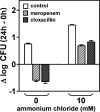Role of acidic pH in the susceptibility of intraphagocytic methicillin-resistant Staphylococcus aureus strains to meropenem and cloxacillin
- PMID: 17307986
- PMCID: PMC1855560
- DOI: 10.1128/AAC.01192-06
Role of acidic pH in the susceptibility of intraphagocytic methicillin-resistant Staphylococcus aureus strains to meropenem and cloxacillin
Abstract
Early studies showed that methicillin-resistant Staphylococcus aureus (MRSA) strains are susceptible to beta-lactams when they are exposed to pH < or = 5.5 in broth. Because S. aureus survives in the phagolysosomes of macrophages, where the pH may be acidic, we have examined the susceptibility of MRSA ATCC 33591 phagocytized by human THP-1 macrophages to meropenem (MEM) and cloxacillin (CLX). Using a pharmacodynamic model assessing key pharmacological (50% effective concentration and maximal efficacy) and microbiological (static concentration) descriptors of antibiotic activity, we show that intraphagocytic MRSA strains are as sensitive to MEM and CLX as methicillin-susceptible S. aureus (MSSA; ATCC 25923). This observation was replicated in broth if the pH was brought to 5.5 and was confirmed with clinical strains. Electron microscopy showed that both the MRSA and the MSSA strains localized and multiplied in membrane-bounded structures (phagolysosomes) in the absence of beta-lactams. Incubation of the infected macrophages with ammonium chloride (to raise the phagolysosomal pH) made MRSA insensitive to MEM and CLX. No difference was seen in mec, mecA, mecI, mecR1, femA, and femB expression (reversed transcription-PCR) or in PBP 2a content (immunodetection) in MRSA grown in broth at pH 5.5 compared with that in MRSA grown in broth at 7.4. The level of [(14)C]benzylpenicillin binding to cell walls prepared from a non-beta-lactamase-producing MRSA clinical isolate was two times lower than that to cell walls prepared from MSSA ATCC 25923 at pH 7.4, but the levels increased to similar values for both strains at pH 5.5. These data suggest that the restoration of susceptibility of intraphagocytic of MRSA to MEM and CLX is due to the acidic pH prevailing in phagolysosomes and is mediated by an enhanced binding to penicillin-binding proteins.
Figures






Similar articles
-
Restoration of susceptibility of intracellular methicillin-resistant Staphylococcus aureus to beta-lactams: comparison of strains, cells, and antibiotics.Antimicrob Agents Chemother. 2008 Aug;52(8):2797-805. doi: 10.1128/AAC.00123-08. Epub 2008 Jun 2. Antimicrob Agents Chemother. 2008. PMID: 18519727 Free PMC article.
-
Activities of ceftobiprole and other cephalosporins against extracellular and intracellular (THP-1 macrophages and keratinocytes) forms of methicillin-susceptible and methicillin-resistant Staphylococcus aureus.Antimicrob Agents Chemother. 2009 Jun;53(6):2289-97. doi: 10.1128/AAC.01135-08. Epub 2009 Mar 16. Antimicrob Agents Chemother. 2009. PMID: 19289525 Free PMC article.
-
Methicillin-resistant Staphylococcus aureus: comparison of susceptibility testing methods and analysis of mecA-positive susceptible strains.J Clin Microbiol. 2001 Nov;39(11):3946-51. doi: 10.1128/JCM.39.11.3946-3951.2001. J Clin Microbiol. 2001. PMID: 11682512 Free PMC article.
-
Intracellular forms of menadione-dependent small-colony variants of methicillin-resistant Staphylococcus aureus are hypersusceptible to β-lactams in a THP-1 cell model due to cooperation between vacuolar acidic pH and oxidant species.J Antimicrob Chemother. 2012 Dec;67(12):2873-81. doi: 10.1093/jac/dks325. Epub 2012 Sep 21. J Antimicrob Chemother. 2012. PMID: 23002174
-
Methicillin-resistant Staphylococcus aureus. Mechanisms of resistance and implications for treatment.Postgrad Med. 2001 Feb;109(2 Suppl):43-50. doi: 10.3810/pgm.02.2001.suppl12.65. Postgrad Med. 2001. PMID: 19667557 Review.
Cited by
-
In vitro antibiotic activity against intraosteoblastic Staphylococcus aureus: a narrative review of the literature.J Antimicrob Chemother. 2021 Nov 12;76(12):3091-3102. doi: 10.1093/jac/dkab301. J Antimicrob Chemother. 2021. PMID: 34459881 Free PMC article. Review.
-
Modeling the Growth and Death of Staphylococcus aureus against Melaleuca armillaris Essential Oil at Different pH Conditions.Antibiotics (Basel). 2021 Feb 23;10(2):222. doi: 10.3390/antibiotics10020222. Antibiotics (Basel). 2021. PMID: 33672314 Free PMC article.
-
Antimicrobial activity against intraosteoblastic Staphylococcus aureus.Antimicrob Agents Chemother. 2015 Apr;59(4):2029-36. doi: 10.1128/AAC.04359-14. Epub 2015 Jan 20. Antimicrob Agents Chemother. 2015. PMID: 25605365 Free PMC article.
-
Skin Barrier Function: The Interplay of Physical, Chemical, and Immunologic Properties.Cells. 2023 Nov 30;12(23):2745. doi: 10.3390/cells12232745. Cells. 2023. PMID: 38067173 Free PMC article. Review.
-
Activity of a novel protonophore against methicillin-resistant Staphylococcus aureus.Future Med Chem. 2017 Aug;9(12):1401-1411. doi: 10.4155/fmc-2017-0047. Epub 2017 Aug 3. Future Med Chem. 2017. PMID: 28771026 Free PMC article.
References
-
- Dikstein, S., and A. Zlotogorski. 1994. Measurement of skin pH. Acta Dermatol. Venereol. Suppl. (Stockholm) 18518-20. - PubMed
-
- Foster, T. J. 2005. Immune evasion by staphylococci. Nat. Rev. Microbiol. 3948-958. - PubMed
-
- Fuda, C., D. Hesek, M. Lee, W. Heilmayer, R. Novak, S. B. Vakulenko, and S. Mobashery. 2006. Mechanistic basis for the action of new cephalosporin antibiotics effective against methicillin- and vancomycin-resistant Staphylococcus aureus. J. Biol. Chem. 28110035-10041. - PubMed
Publication types
MeSH terms
Substances
LinkOut - more resources
Full Text Sources
Medical
Molecular Biology Databases
Research Materials
Miscellaneous

